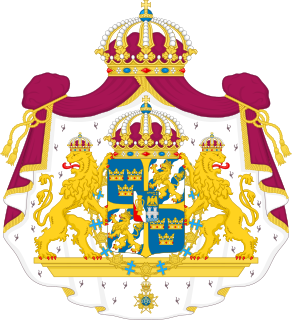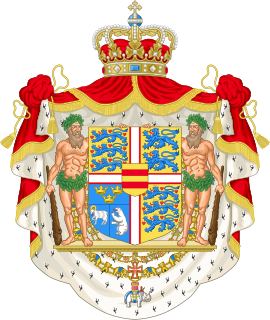
The coat of arms of the Kingdom of Sweden has a lesser and a greater version.

In heraldry, an ordinary is a simple geometrical figure, bounded by straight lines and running from side to side or top to bottom of the shield. There are also some geometric charges known as subordinaries, which have been given lesser status by some heraldic writers, though most have been in use as long as the traditional ordinaries. Diminutives of ordinaries and some subordinaries are charges of the same shape, though thinner. Most of the ordinaries are theoretically said to occupy one-third of the shield; but this is rarely observed in practice, except when the ordinary is the only charge.

The city of Cracow uses a coat of arms, a seal, official colors, a flag, and a banner as its official symbols. Additionally, a number of semi-official and unofficial symbols of the city are also used.

The coat of arms of Romania was adopted in the Romanian Parliament on 10 September 1992 as a representative coat of arms for Romania. It is based on the Lesser Coat of Arms of the Kingdom of Romania, redesigned by Victor Dima. As a central element, it shows a golden aquila holding a cross in its beak, and a mace and a sword in its claws. It also consists of the three colors which represent the colors of the national flag. The coat of arms was augmented on 11 July 2016 to add a representation of the Steel Crown of Romania.

The coat of arms of Castile and León depicts the traditional arms of Castile quartered with the arms of León. It is topped with a royal crown.

The coat of arms of Spain represents Spain and the Spanish nation. It appears on the flag of Spain and it is used by the Government of Spain, the Cortes Generales, the Constitutional Court, the Supreme Court, and other state institutions. In its design, the medieval kingdoms that would unite to form Spain, the Royal Crown, national sovereignty, the constitutional monarchy, the Spanish national motto: Plus Ultra, and the Pillars of Hercules are represented. The Monarch, the heir to the throne and some institutions like the Senate, the Council of State or the General Council of the Judiciary have their own arms.

The Republic of Turkey has no official national emblem, but the star and crescent design from the national flag is in use as de facto emblem, among other things printed on Turkish passports, on Turkish identity cards and diplomatic missions of Turkey.

The flag of Los Angeles, California, consists of a background of three notched stripes of green, gold and red. The colors represent olive trees (green), orange groves (gold) and vineyards (red). The flag was designed by Roy E. Silent and E.S. Jones in 1931 for the Los Angeles sesquicentennial from 1781.

The national coat of arms of Denmark consists of three pale blue lions passant wearing crowns, accompanied by nine red lilypads, all in a golden shield. It is historically the coat of arms of the House of Estridsen, the dynasty which provided the Kings of Denmark between 1047 and 1412. The current design was introduced in 1819, under Frederick VI. Previously, there had been no distinction between the "national" and the "royal" coat of arms. Since 1819, there has been a more complex royal coat of arms of Denmark (kongevåben) separate from the national coat of arms (rigsvåben).

The coat of arms of Portugal is the main heraldic insignia of Portugal. The present model was officially adopted on 30 June 1911, along with the present model of the Flag of Portugal. It is based on the coat of arms used by the Portuguese Kingdom since the Middle Ages. The coat of arms of Portugal is popularly referred as the Quinas.

The coat of arms of Gibraltar was first granted by a Royal Warrant passed in Toledo on 10 July 1502 by Isabella I of Castile during Gibraltar's Spanish period. The arms consists of an escutcheon and features a three-towered red castle under which hangs a golden key.

The coat of arms of Bucharest is the heraldic symbol of the capital city of Romania. The present-day coat of arms was adopted by Domnitor Alexandru Ioan Cuza, and changed under the Communist regime. In 1994, it was renewed again with minor alterations.

Portuguese heraldry encompasses the modern and historic traditions of heraldry in Portugal and the Portuguese Empire. Portuguese heraldry is part of the larger Iberian tradition of heraldry, one of the major schools of heraldic tradition, and grants coats of arms to individuals, cities, Portuguese colonies, and other institutions. Heraldry has been practiced in Portugal at least since the 11th century, however it only became standardized and popularized in the 16th century, during the reign of King Manuel I of Portugal, who created the first heraldic ordinances in the country. Like in other Iberian heraldic traditions, the use of quartering and augmentations of honor is highly representative of Portuguese heraldry, but unlike in any other Iberian traditions, the use of heraldic crests is highly popular.

The coat of arms of Kropyvnytskyi is one of the city's symbols reflecting its past and the controversies of its history.

The coat of arms of Bavaria has greater and lesser versions.

The coat of arms of Buzău is the heraldic symbol standing for the city of Buzău, Romania. The city's first recorded coat of arms dates back to 1831, and since then, the coat of arms has mostly kept its features, under different designs.

The coat of arms of the Extremadura is described in the Title I of the Spanish Law 4 of June 3, 1985, the Law of the coat of arms, flag and regional day of Extremadura.
A national coat of arms is a symbol which denotes an independent state in the form of a heraldic achievement. While a national flag is usually used by the population at large and is flown outside and on ships, a national coat of arms is normally considered a symbol of the government or the head of state personally and tends to be used in print, on heraldic china, and as a wall decoration in official buildings. The royal arms of a monarchy, which may be identical to the national arms, are sometimes described as arms of dominion or arms of sovereignty.

The coat of arms of Barcelona is the official emblem of the City Council of Barcelona, the capital of Catalonia, has its origin in the Middle Ages, these arms were first documented in in 1329. The Government of Catalonia conferred the coat of arms and the flag as official symbols of the municipality in 2004. It has an escutcheon in lozenge which is commonly used in municipal coats of arms of cities in Catalonia. Currently the City Council of Barcelona also uses a isotype based on the heraldry of the city.

The University of Dayton (UD) is an American private Roman Catholic national research university in Ohio's sixth-largest city, Dayton. Founded in 1850 by the Society of Mary (Marianists), it is one of three Marianist universities in the nation and the second-largest private university in Ohio. The university's campus is in the city's southern portion and spans 388 acres on both sides of the Great Miami River. The campus is noted for the Immaculate Conception Chapel and the University of Dayton Arena. The University also operates in China's Suzhou Industrial Park, the University of Dayton China Institute.

The California Historical Society, located at 678 Mission Street at the corner of Annie Street in the South of Market neighborhood of San Francisco, California is the state's official historical society since 1979.

The Los Angeles Times is a daily newspaper which has been published in Los Angeles, California, since 1881. It has the fourth-largest circulation among United States newspapers, and is the largest U.S. newspaper not headquartered on the east coast. The paper is known for its coverage of issues particularly salient to the U.S. west coast, such as immigration trends and natural disasters. It has won more than 40 Pulitzer Prizes for its coverage of these and other issues. As of June 18, 2018, ownership of the paper is controlled by Patrick Soon-Shiong, and the executive editor is Norman Pearlstine.




























